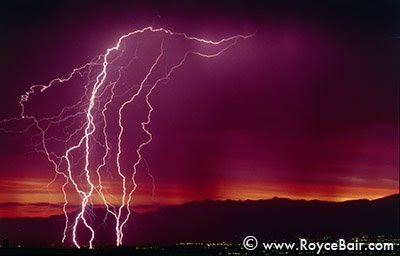 (Click on image for a larger view, or click here to see a series of four images on my Flickr photostream.)
(Click on image for a larger view, or click here to see a series of four images on my Flickr photostream.)I think lightning photographs continue to amaze people because of their awesome force, and because they are a very graphic icon of nature's power that is often used to represent power in modern technologies. And because of this relationship, I've made many stock photo sales from my lightning images.
Photographing lightning is relatively simple: the camera's shutter is manually opened until one of more lightning strikes occur within the camera's field of vision. The lightning itself acts as an electronic flash -- exposing itself or freezing the image onto the digital sensor or film. (An manual exposure setting of f8 for an ISO of 100 will work as a starting point under most conditions.)
The real trick is guessing where best to aim the camera, and how long to leave the shutter open. Pointing the camera where recent lightning strikes have occurred is the best wisdom, with adjustments based on the storm's speed and direction. Some photographers will shoot "wide" and crop in using Photoshop. (All of my lightning photos are uncropped.)
Time exposures can be often produce surprises (good and bad). The longer you leave the shutter open, the more lightning strikes appear in the image, usually making for a more dramatic image. And the movement of the clouds during a long exposure can produce some dreamy effects. However, leaving the shutter open too long can also wash out the details of clouds and surrounding landscape, especially if there are bright city lights or leftover twilight from a sunset (or impending dawn).
If all this seems too technical, don't worry, most point-and-shoot cameras will automatically set the aperture or "f-stop" and close the shutter when enough light has reached the camera's image sensor (just keep in mind that most P&S cameras cannot time expose longer than 30 seconds, so some of your options are limited). Consult your manual for time-exposure menu settings. (It should go without saying that all this requires a steady tripod.) For more technical information and tips on lightning photography, refer to this Matthew Cole page, this LightningBoy page, or Guy Tal's Mountain Trail Photo Blog.
You can also view my Flickr Photostream to see more of "My Vision."


No comments:
Post a Comment